- Sales book entries: your sales to customers (cannot be printed nor emailed)
- OR sales invoices: invoices to your customers. These are more detailed than sales book entries. You can add various invoice lines. Sales invoices can be printed and emailed.
- You can also record customer credit notes.
1: What type of transactions should be entered to the sales book?
2: How do I add a transaction?
- Click into the relevant book.
- Click onto the correct tabbed month along the top of the screen.
- Click ‘Add’ (or ‘Receipts’ if you wish to add a receipt, or ‘Payments’ if you wish to add a payment in the Cash Book). NB if you are in the sales book, select ‘Sales Book Entry’ or ‘Sales Invoice’ and click ‘OK’.
- Fill in/select the relevant information.
- Click ‘Save’ (Note, there is a ‘Sales/Lodge’ button also in the cash book which you can use if relevant).
- Follow any additional onscreen prompts.
- You can add another transaction straight away when the fields show blank after saving, or click ‘Cancel’ to close that dialog box.
3: How do I change a transaction?
- Highlight the relevant transaction.
- Enter the default password of ZZZ
- Click ‘Change’.
- Make the relevant changes.
- Click ‘Save’.
4: How do I delete a transaction?
- Highlight the relevant transaction.
- Enter the default password of ZZZ
- Click ‘Delete’.
- Click ‘Yes’.
5: How do I add/create a sales invoice?
- Click into the sales book.
- Click into the relevant tabbed month along the top.
- Click ‘Add’.
- Click ‘Sales Invoices’.
- Select the correct ‘Date’.
- Choose the customer’s account in the ‘Account’ field.
- Fill in any other fields if required (number, comments etc.).
- Click ‘Add’ under the ‘Detail’ section to add line items.
- Click ‘Product’ if you want to add setup products to your invoice (you can also create products from there).
- Type in ‘Details’ as necessary, the ‘Quantity’, ‘Unit price’ and ‘Vat Rate’ & enter the amount of (unit price x quantity) into or across the analysis category(s) (if you select a product, much of this information will automatically fill in).
- Click ‘Save’.
- Add other line items if necessary or click ‘Cancel’.
- You can add/change/delete any of the line items.
- Click ‘Save’.
- Click ‘Cancel’.
6: What is an example of the figures entered to the various fields on a sales book entry?
- Click ‘Setup’.
- Click ‘Multi-user Preferences.
- Un-tick any of the books that you wish to be able to enter a reference.
- Click ‘Save’.
- Please look at is example for how an entry can be made: €123 (figure includes VAT).
- Total = Total + VAT (e.g. €123).
- Total VAT = VAT (e.g. €23).
- VAT Analysis = Net (e.g. €100).
- Analysis Category = Net (e.g. 100). Note: You can split the net amount across a number of analysis categories
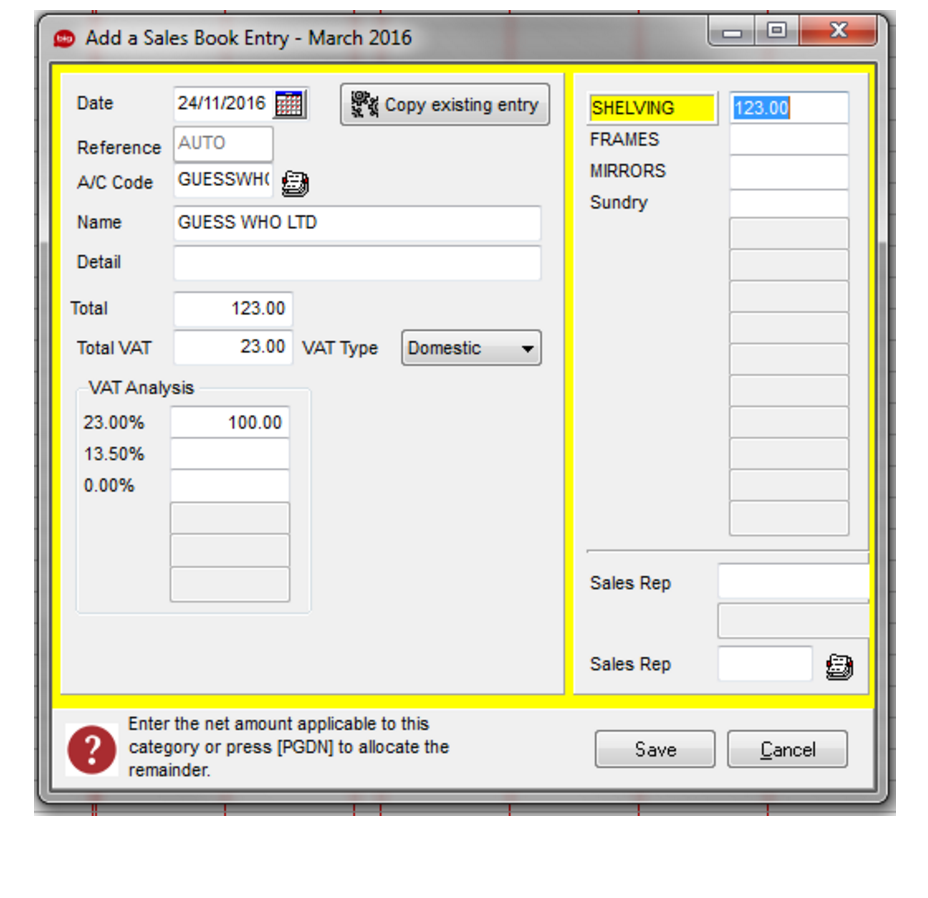
7: How do I add a credit note (customer/sales side)?
- Open the sales book.
- Choose the correct tabbed month along the top.
- Click ‘Add’.
- If you wish to enter it with line items and/or be able to print/email then click ‘Sales Invoice’.
- Where it reads ‘Inv/Crn’ change it to ‘Sales Credit Note’.
- Continue adding it as you would a sales invoice (minus figures will automatically show where appropriate).
- Alternatively, if you do not need to print/email the credit note nor add line items, then you can simply add it as a sales book entry but enter the minus symbol in front of all the figures.
- Click ‘Save’.
8: How do I change the reference from ‘Auto’ for purchases and/or sales?
- Click ‘Setup’.
- Click ‘Multi-user Preferences.
- Un-tick any of the books that you wish to be able to enter a reference.
- Click ‘Save’.
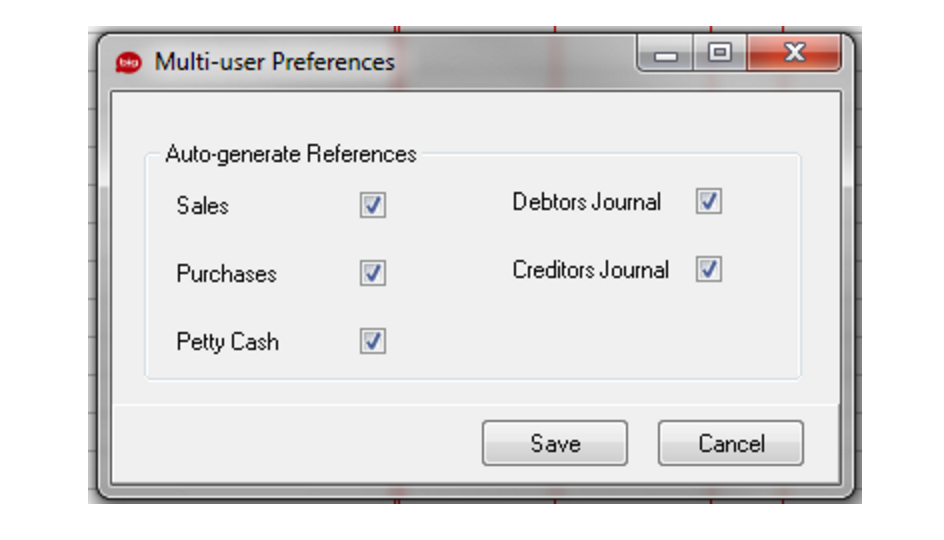
9: How do I start using receipts payments manual allocation?
- Note: If you start using receipts payments manual allocations, you will need to manually allocate customer/supplier transactions (when they are paid/allocated), or they will be seen as unpaid/unallocated within Big Red Book. This includes transactions already added in the current year in Big Red Book, transactions from previous years if you had previous years in Big Red Book, and transactions that you add going forward.
- To start using this, go to ‘Setup’ – ‘Options’ and switch ‘Receipts/Payments Manual Allocations’ to ‘Yes’.
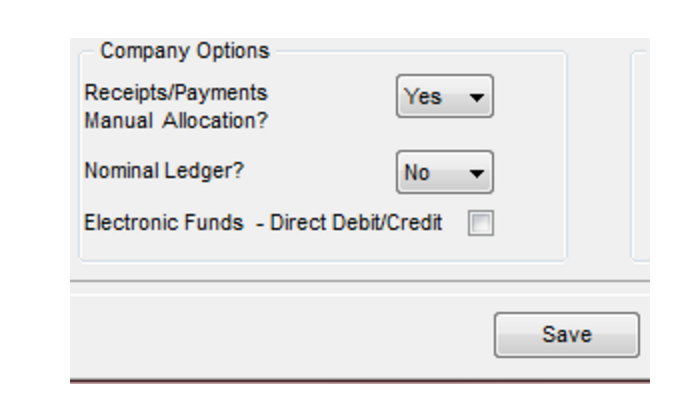
- You will now get the option to allocate customer/supplier receipts/payments when you are adding them. You will also be able to allocate them from within the cash book/payments book and within the customer/supplier ledger.
- Note: If you are using receipts payments manual allocations and Vat on cash receipts, where the vat is based on the allocation of the receipt, you will need to ‘Submit’ the vat return within Big Red Book. This is not the actual VAT Submission, but it marks the allocated transactions in the period selected (and previous period’s transactions not ‘submitted’) to that period for the Vat on Cash Receipts return in Big Red Book, that way those transactions aren’t ‘submitted’ again in a later Big Red Book Vat on Cash Receipts report.
10: How do I allocate a receipt/payment against an invoice?
- You can only do this if you are using receipts/payments manual allocation.
- When adding the receipt/payment and clicking ‘Save’ an ‘Allocation’ dialog box will show.
- Highlight the transaction that you wish to allocate the receipt/payment against.
- Click ‘Auto Allocate’ if you wish to allocate the full amount of the receipt/payment against the highlighted transaction.
- OR click ‘Allocate’ if you wish to allocate part of the receipt/payment against the highlighted transaction or if you wish to enter a discount. Enter the figures as relevant and click ‘Save’.
- Click ‘Save’.
- Note: You can also do this same process by highlighting the relevant receipt/payment and click ‘Allocations’ at the bottom of the screen which will bring up the Allocations dialog box and you can Auto Allocate, Allocate and/or enter a Discount as above. You can also do this from the Customers/Supplier’s ledger (‘Lookup’ – ‘Customers’/’Suppliers’ – Ledger’).
11: How do I allocate older receipts/payments?
- Click ‘Lookup’/’Setup’.
- Highlight the Customer/Supplier.
- Click ‘Ledger’.
- Click into the receipt/payment that you wish to allocate.
- Click ‘Allocate’.
![]()
12: How do I allocate a credit invoice against an invoice?
- Enter a cash receipt for the customer with a total of 0.00.
- You will need to enter a receipt for the relevant customer and enter it with a total of 0.00, when you go to allocate this receipt you can allocate the credit note against the invoice on the allocations screen.
- You can only do this if you are using receipts/payments manual allocation.
13: How do I un-allocate/reverse an allocation of a receipt/payment?
- Click ‘Lookup’/’Setup’.
- Click ‘Customers’/’Suppliers’.
- Highlight the customer or supplier.
- Click ‘Ledger’.
- Highlight the relevant receipt/payment.
- Click ‘View’.
- Click ‘View Allocations’.
- Highlight the allocation that you want to reverse.
- Click ‘Reverse Allocation’.
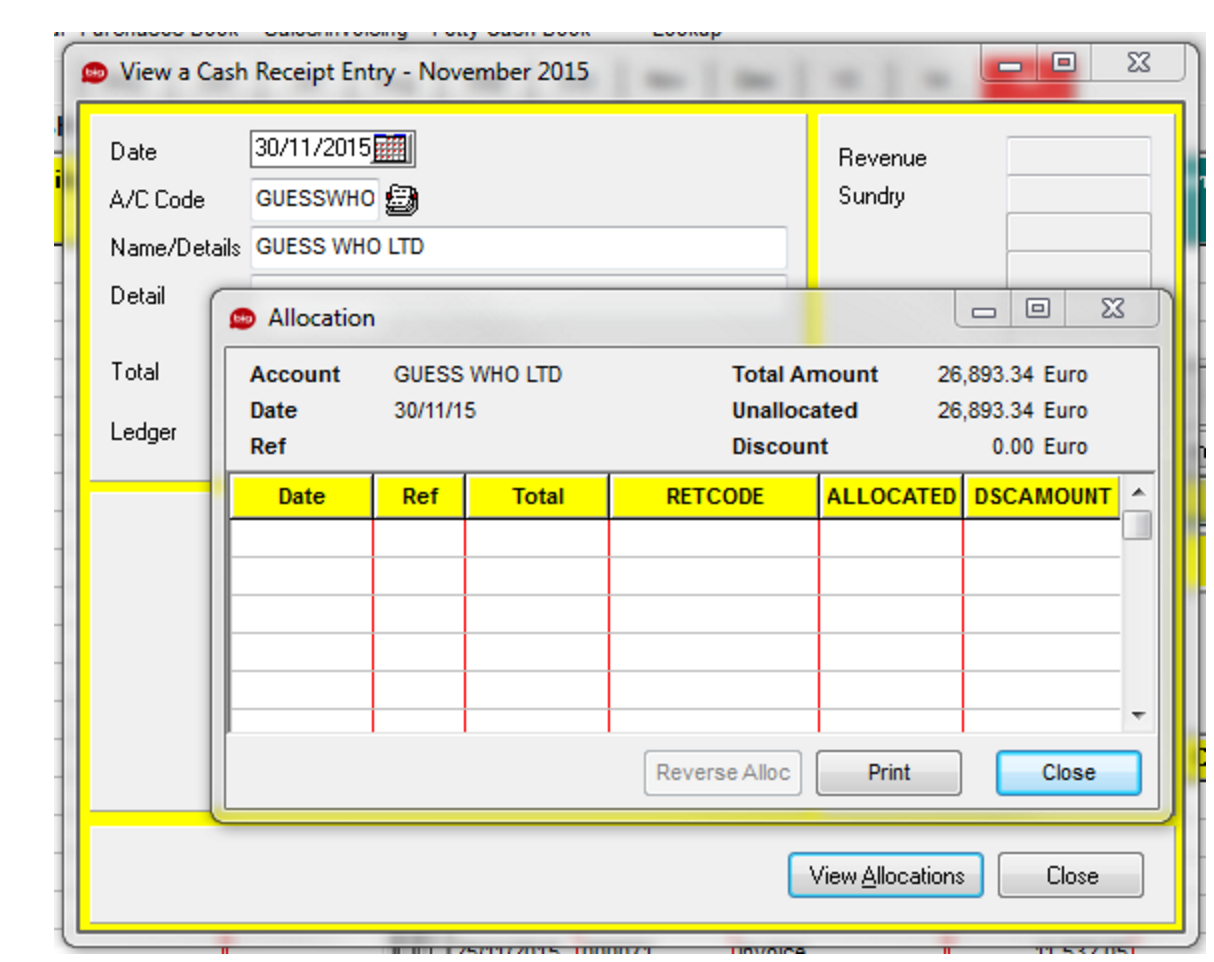
- Click ‘Close’.
- Note: You can also do this from the book that the transactions are entered (cash book or payments book) by highlighting the transaction, clicking ‘View’ and following steps as above (from ‘View’ downward).
For sales: when adding the sales invoice, tick the ‘Type 2 Invoice Layout’ button. This will show this invoice when previewing/printing with the line ‘VAT on this supply to be accounted for by the principal contactor’ and it will not display a VAT breakdown.
14: How do I setup Big Red Book so that I can email invoices/statements?
- Click ‘Setup’ – ‘Company Details’ – ‘Email Setup’.
- Under the ‘SMTP Settings’ enter the required details (you should be able to get these online or from the providers of your email account or if there is an I.T person that works with you).
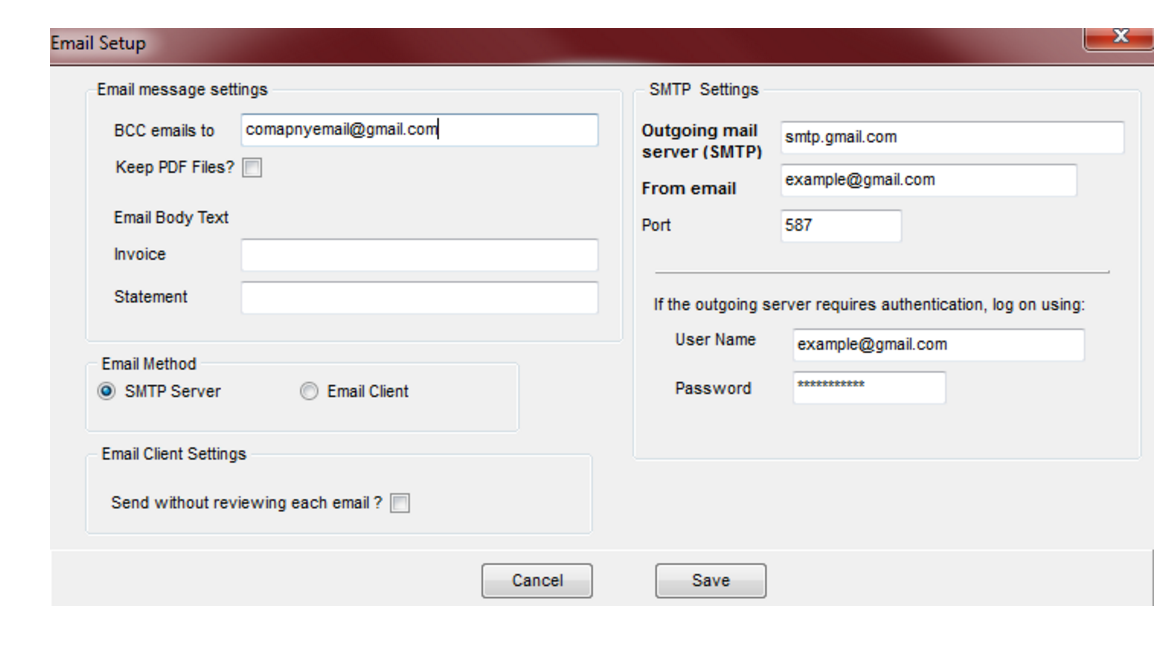
- Click on ‘Sales’ and enter the Email Title (e.g. Invoice from ‘your company’…), Email Body (e.g. Please find attached Invoice) and ‘BCC’ (if relevant, i.e. if you wish to track sent emails, you could type your own email address in there). Click ‘Statements’ and do the same for statements.
- Click ‘Save’.
- Click ‘Setup’ – ‘Customers’.
- Highlight the customer that you want to enter their email address.
- Click ‘Change’.
- Type their email address into ‘Email’.
- Click ‘Save’.
- Do the same for any other customers where you want to add their email address.
- You are now ready to start emailing customer invoices, credit notes and statements.
15: How do I email customer invoices, credit notes and statements?
- First follow the instructions in the FAQ ‘How to do the email setup in Big Red Book?’.
- Next: Before displaying the Invoice(s), Credit Note(s), Statement(s) you will see an ‘Email’ button below the ‘Print/Email’ button. Note: if it is statement(s) ensure to first select the ‘Period’, ‘Customer(s), and ‘Min balance’ (any statements below the min balance will not email e.g. if min balance is 0.50, then a customer statement with the balance 0.49 will not display).
- Click ‘Email’.
- Type a message into ‘Message Body’ if you wish.
- Type your email address in ‘BCC’ if you want to BCC the email to yourself – to track sent emails from Big Red Book.
- Click ‘Send’.
- It should show message that the email(s) have been sent.
16: How do I track sent emails of invoices/statements?
- If you are using SMTP Settings (In Setup – Company Details – Email Setup), you can enter an email address in ‘BCC’ to also send the invoices/statement to e.g. your own email address and you can track them this way.
- If you are not using SMTP, there is still a ‘BCC’ you can use before you send the invoices/statements. Note: in this case, you would need to type in the email address to BCC each time you email invoices/statements.
- If you were not using BCC up to now, you cannot track what invoices/emails were already emailed from Big Red Book.
17: How do I deal with a cancelled/bounced cheque from a customer in Big Red Book?
- First consider what accounts (customer, nominal, bank etc.) were affected by the initial transaction(s) (if initial transactions were added) and consider how you now want to affect those accounts.
- If the initial transactions were a sales entry and a cash receipt saved and lodged, then if you now wish to show the money leaving your bank account (as it never entered it, but had been shown as having entered it by the lodgement) and the customer’s ledger being adjusted by that amount, you can record a non-ledger (non-supplier) payments book entry from your relevant bank account. The record a debtor journal adjustment, on the debit side (to correct the customer ledger). Next, view the ledgers of the accounts affected to ensure that all is showing as it should be. After this it will show that the invoice is still owing. If you no longer wish to show the invoice as owing, you can record a credit note in the sales book.
- Note: regarding the non-ledger payment, you could set up an analysis category (‘Setup’ – ‘Analysis Categories’) for this e.g. calling it ‘cancelled’ or something similar, so that you know what it refers to. If you are using the nominal ledger you can select/add a nominal account for this, beside that category (‘Setup’ – ‘Analysis Categories’) and then when doing the journal adjustment, you could select the same nominal to offset the journal adjustment against.
- You should check the ledgers of all affected accounts after to ensure all is showing as it should be.
18: How do I record a refund to a customer in Big Red Book?
- First consider what accounts (customer, nominal, bank etc.) were affected by the initial transaction(s) (if initial transactions were added) and consider how you now want to affect those accounts.
- If the initial transactions were a sales entry and a cash receipt saved and lodged, then if you now wish to show the money leaving your bank account (as it never entered it, but had been shown as having entered it by the lodgement) and the customer’s ledger being adjusted by that amount, you can record a non-ledger (non-supplier) payments book entry from your relevant bank account. The record a debtor journal adjustment, on the debit side (to correct the customer ledger). Next, view the ledgers of the accounts affected to ensure that all is showing as it should be. After this it will show that the invoice is still owing. If you no longer wish to show the invoice as owing, you can record a credit note in the sales book.
- Note: regarding the non-ledger payment, you could set up an analysis category (‘Setup’ – ‘Analysis Categories’) for this e.g. calling it ‘cancelled’ or something similar, so that you know what it refers to. If you are using the nominal ledger you can select/add a nominal account for this, beside that category (‘Setup’ – ‘Analysis Categories’) and then when doing the journal adjustment, you could select the same nominal to offset the journal adjustment against.
- You should check the ledgers of all affected accounts after to ensure all is showing as it should be.
19: How do I see a summary of the figures for my analysis categories?
- Within the book that you want to see this for, click ‘Reports’.
- Choose the ‘Summary’ or ‘Details’ Report.
- With sales book and purchases book ensure ‘Analysis’ is select before you display it.
- With the payments book ensure that the relevant bank is selected at the bottom of the screen.
- With the cash book, you can run the ‘Listing’ reports for receipts and payments.
20: How can I account for VAT on reverse charge basis in Big Red Book?
For purchases: when adding the purchase book entry in the ‘VAT Type’ field choose ‘Reverse Charge’ and then enter the transaction. Note: the ‘Total’ figure is the net figure in this case, rather than the gross figure.

For sales: when adding the sales invoice, tick the ‘Type 2 Invoice Layout’ button. This will show this invoice when previewing/printing with the line ‘VAT on this supply to be accounted for by the principal contactor’ and it will not display a VAT breakdown.
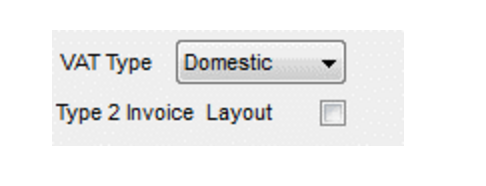
21: Can I change a customer account code/ supplier account code/ bank account code?
- You cannot change a supplier, customer or bank account code once it has been setup.
- If it is something that you must change, then you can delete the customer / supplier / bank account and then add them again with the correct account code.
- Note: You will not be able to delete a customer / supplier or bank account if there are transactions against their ledger.
How do I enter opening balances for customers and suppliers when receipts payments manual allocations is not being used?

- Click ‘Setup’/’Lookup’ – ‘Customers’/’Suppliers’.
- Highlight the relevant customer/supplier.
- Click ‘Change’.
- Click ‘O/Balance’.
- Click into the ‘Current’, ‘1 Month’, ‘2 Months’ and ‘3 Months Plus’ fields and enter the portion of the opening balance which is relevant to each/any of these fields. On entering the value(s) the ‘Balance starting from’ field is automatically updated.
- Click ‘OK’.
- Click ‘Save’ on the ‘Customer/Supplier’ screen – this is the point at which the opening balance is actually saved.
- Note: While it is recommended that you should enter the ageing of the opening balance, if you do not know the ageing, Big Red Book will still allow you can enter the full balance in the any of the ageing fields.











